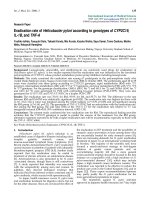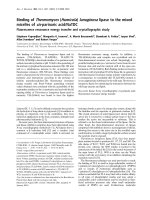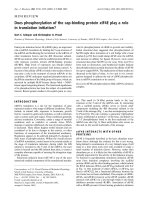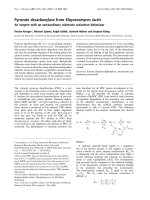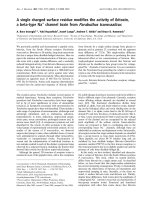Báo cáo y học: "Does switching from oral extended-release methylphenidate to the methylphenidate transdermal system affect health-related quality-of-life and medication satisfaction for children with attention-deficit/hyperactivity disorder&
Bạn đang xem bản rút gọn của tài liệu. Xem và tải ngay bản đầy đủ của tài liệu tại đây (597.82 KB, 12 trang )
BioMed Central
Page 1 of 12
(page number not for citation purposes)
Child and Adolescent Psychiatry and
Mental Health
Open Access
Research
Does switching from oral extended-release methylphenidate to the
methylphenidate transdermal system affect health-related
quality-of-life and medication satisfaction for children with
attention-deficit/hyperactivity disorder?
Oscar G Bukstein*
1
, L Eugene Arnold
2
, Jeanne M Landgraf
3
and
Paul Hodgkins
4
Address:
1
Western Psychiatric Institute and Clinic, University of Pittsburgh School of Medicine, Pittsburgh, Pennsylvania, USA,
2
The Ohio State
University, Columbus, Ohio, USA,
3
HealthActCHQ Inc, Cambridge, Massachusetts, USA and
4
Shire Development, Inc, Wayne, Pennsylvania, USA
Email: Oscar G Bukstein* - ; L Eugene Arnold - ; Jeanne M Landgraf - ;
Paul Hodgkins -
* Corresponding author
Abstract
Background: To evaluate health-related quality of life (HRQL) and medication satisfaction after switching from a stable dose
of oral extended-release methylphenidate (ER-MPH) to methylphenidate transdermal system (MTS) via a dose-transition
schedule in children with attention-deficit/hyperactivity disorder (ADHD).
Methods: In a 4-week, multisite, open-label study, 171 children (164 in the intent-to-treat [ITT] population) aged 6-12 years
diagnosed with ADHD abruptly switched from a stable dose of oral ER-MPH to MTS nominal dosages of 10, 15, 20, and 30 mg
using a predefined dose-transition schedule. Subjects remained on the scheduled dose for the first week, after which the dose
was then titrated to an optimal effect. The ADHD Impact Module-Children (AIM-C), a disease-specific validated HRQL survey
instrument measuring child and family impact, was used to assess the impact of ADHD symptoms on the lives of children and
their families at baseline and study endpoint. Satisfaction with MTS use was assessed via a Medication Satisfaction Survey (MSS)
at study endpoint. Both the AIM-C and MSS were completed by a caregiver (parent/legally authorized representative).
Tolerability was monitored by spontaneous adverse event (AE) reporting.
Results: AIM-C child and family HRQL mean scores were above the median possible score at baseline and were further
improved at endpoint across all MTS doses. Similar improvements were noted for behavior, missed doses, worry, and economic
impact AIM-C item scores. Overall, 93.8% of caregivers indicated a high level of satisfaction with their child's use of the study
medication. The majority of treatment-emergent AEs (> 98%) were mild to moderate in intensity, and the most commonly
reported AEs included headache, decreased appetite, insomnia, and abdominal pain. Seven subjects discontinued the study due
to intolerable AEs (n = 3) and application site reactions (n = 4).
Conclusion: This study demonstrates that MTS, when carefully titrated to optimal dose, may further improve child and family
HRQL, as well as behavioral, medication worry, and economic impact item scores, as measured by the AIM-C in subjects
switching to MTS from a stable dose of routinely prescribed oral ER-MPH after a short treatment period. Furthermore, following
the abrupt conversion from oral ER-MPH to MTS, the majority of caregivers reported being highly satisfied with MTS as a
treatment option for their children with ADHD.
Trial Registration: NCT00151983
Published: 10 December 2009
Child and Adolescent Psychiatry and Mental Health 2009, 3:39 doi:10.1186/1753-2000-3-39
Received: 26 June 2009
Accepted: 10 December 2009
This article is available from: />© 2009 Bukstein et al; licensee BioMed Central Ltd.
This is an Open Access article distributed under the terms of the Creative Commons Attribution License ( />),
which permits unrestricted use, distribution, and reproduction in any medium, provided the original work is properly cited.
Child and Adolescent Psychiatry and Mental Health 2009, 3:39 />Page 2 of 12
(page number not for citation purposes)
Background
Attention-deficit/hyperactivity disorder (ADHD) is a com-
mon psychiatric disorder of childhood, affecting an esti-
mated 7-10% of school-aged children [1-3] and often
persists into adolescence and even adulthood [4-7].
Beyond a greater risk for developing mental health comor-
bidities such as mood and substance use disorders [8-11],
children with ADHD struggle with impairment in aca-
demic functioning, self-esteem, and interpersonal rela-
tionships [12,13]. Families of children with ADHD
frequently experience considerable emotional and finan-
cial stressors [14,15]. These harmful effects of ADHD on
patients and families make it a public health concern and
affirm the need for effective treatment [16].
Psychostimulants are recognized as one of the first-line
treatments for children with ADHD [1,3,13,17], and
methylphenidate (MPH) has been established as an effec-
tive agent in reducing ADHD symptoms [18,19]. Accord-
ingly, oral MPH formulations are frequently prescribed
medications for this disorder [20]. The methylphenidate
transdermal system (MTS; Daytrana
®
[Shire Pharmaceuti-
cals Ireland Ltd., Dublin, Ireland]), an alternative to oral
MPH formulation, is approved by the US Food and Drug
Administration (FDA) as part of a comprehensive treat-
ment for ADHD in children aged 6-12 years [21]. MTS is
a diffusion-based patch, using DOT Matrix
®
technology
(Noven Pharmaceuticals, Miami, FL), that continuously
delivers racemic MPH when applied to intact skin [22].
The dose of drug delivered depends on the surface area of
the patch and the length of time that the patch is worn,
which allows for tailoring the duration of medication
effect with reductions of first-pass metabolism and fluctu-
ating plasma concentrations encountered with oral medi-
cations [23,24]. The efficacy and tolerability of MTS have
been demonstrated in several clinical studies of school-
aged children [25-28].
ADHD treatments, such as MTS, can lead to reduced fre-
quency or severity of symptoms; however, these treat-
ments may not directly translate to improvements in the
patient's health-related quality of life (HRQL) at home, at
school, or with peers. The behavior rating scales com-
monly used to assess efficacy are not specifically designed
to evaluate the effect of treatment on the everyday lives of
children and families living with ADHD. In recent years,
the development of multidimensional HRQL question-
naires has afforded clinicians the opportunity to measure
the health of children with ADHD more comprehensively
[29-37]. Subsequently, a number of reports have been
published regarding the improvement of HRQL for chil-
dren with ADHD receiving pharmacotherapy, primarily
atomoxetine, a nonstimulant medication approved by the
FDA for the treatment of ADHD [38-46]. To date, there are
no published data documenting changes in HRQL after
subjects switch from oral ER-MPH to MTS. The purpose of
this research was to examine whether changes in HRQL
and medication satisfaction occur after switching from a
stable oral ER-MPH dose to a carefully titrated, optimized
dose of MTS after 4 weeks of treatment.
Subjects and Methods
Subjects
Children aged 6-12 years, with a confirmed diagnosed of
ADHD (any subtype) by the Diagnostic and Statistical Man-
ual of Mental Disorders Fourth Edition, Text Revision (DSM-
IV-TR
®
, [American Psychiatric Publishing, Inc., Arlington,
VA]), and whose parent/legally authorized representative
(hereafter referred to as caregiver) was considering a
change in treatment based on efficacy, tolerability, or
compliance were eligible to participate in the study. Sub-
jects were required to have their ADHD symptoms ade-
quately controlled on a stable dose of oral ER-MPH
(Ritalin LA
®
[Novartis AG, Basel, Switzerland], Concerta
®
[Alza Corporation, Palo Alto, CA], or Metadate CD
®
[UCB
Inc., Atlanta, GA] not to exceed 54 mg/day) for at least 30
days prior to screening. At baseline, subjects were required
to have a total score of ≤ 1.5 standard deviations (SDs)
from age-appropriate norms on the ADHD-Rating Scale-
IV (ADHD-RS-IV) [27], normal laboratory parameters,
vital signs, electrocardiogram (ECG), and a body mass
index (BMI) not exceeding the 90
th
percentile.
Based on medical history collected at screening, children
were excluded from study enrollment if they had any
comorbid psychiatric diagnosis (with the exception of
oppositional defiant disorder), mental retardation, or any
concurrent illness or skin disorder that might compro-
mise safety or study assessments. Subjects could not have
taken clonidine, atomoxetine, antidepressants, antihyper-
tensives, medications with central nervous system effects,
sedatives, antipsychotics, anxiolytics, anticonvulsants, or
other investigational medications within 30 days prior to
screening.
Data were collected at 18 sites across the United States; the
Institutional Review Board at each site or a central Institu-
tional Review Board approved the study. The subject
agreed to the study and the subject's caregiver provided
written consent in accordance with the International Con-
ference on Harmonisation Good Clinical Practice Guide-
line E6 and applicable regulations.
Study design
This was a prospective, open-label, multicenter study of
MTS primarily designed to evaluate effectiveness and tol-
erability after abrupt conversion from ER-MPH to MTS
[47]; however, important secondary objectives, HRQL
and medication satisfaction, were also evaluated and are
the primary focus of this report.
Child and Adolescent Psychiatry and Mental Health 2009, 3:39 />Page 3 of 12
(page number not for citation purposes)
The study consisted of 4 experimental periods: screening,
baseline/MTS initiation, MTS adjustment, and MTS main-
tenance (Figure 1). In addition, a follow-up phone call
was made to caregivers 30 days following the last dose of
study drug to access any additional or ongoing adverse
events (AEs).
Subjects entered the screening period on their existing
dose of oral ER-MPH and continued that medication until
the baseline visit at which time they were switched to MTS
using a predefined dose-transition schedule (Table 1).
Patches were to be applied to alternating hips once daily
in the morning and worn for up to 9 hours each day. Sub-
jects remained on their initial MTS transition dose for 1
week and then entered a 2-week dose-adjustment period.
Titration to a higher dose or tapering to a lower dose of
MTS was permitted based on tolerability and scores on the
Clinical Global Impression-Severity (CGI-S) scale. For
titration purposes, response to MTS was categorized by
the investigator into 1 of 4 conditions and associated
actions: "Intolerable" (unacceptable safety profile); "Inef-
fective" (if the subject's CGI-S score had become worse
compared with baseline, or the subject had a CGI-S score
of 4 [moderately ill] or worse); "Acceptable" (similar or
better ADHD symptom control compared with the base-
line ADHD-RS-IV score, with minimal side effects and
CGI-S score of 3 [mildly ill] or better); or "Optimal", indi-
cating superior ADHD symptom control (CGI-S score of 2
[borderline mentally ill] or 1 [not ill at all, normal]).
"Intolerable" responses required the subject to be tapered
to a lower dose, if available. "Ineffective" responses
required increasing the subject's MTS dose to the next
available strength if side effects permitted. "Acceptable"
responses permitted the subject to be maintained on the
current dose for the remainder of the dose-optimization
MTS abrupt conversion study designFigure 1
MTS abrupt conversion study design. MTS = methylphenidate transdermal system; MPH = methylphenidate.
Week -1 Week 0 Week 1 Week 2 Week 3 Week 4
Screening Baseline Termination
MTS
Initiation
MTS Titration
Stable
Dose
MTS
Requisite of 30 days
on previous MPH
preparation
30 day
follow-up
Previous
MPH
Product
Metadate CD
®
Ritalin LA
®
Concerta
®
Visit 1
Visit 2
Visit 3
Visit 5
Visit 6
Visit 4
5 Week Dose Optimization
Child and Adolescent Psychiatry and Mental Health 2009, 3:39 />Page 4 of 12
(page number not for citation purposes)
phase or, if in the investigator's opinion there was poten-
tial for further symptom reduction, try the next higher
dose. No further titration was permitted after the final
dose-adjustment visit at the end of week 3, and subjects
were maintained on their dose of MTS through the final
week. Subjects were followed up via phone call to caregiv-
ers at 30 ± 3 days after the last dose of study medication to
assess any new or ongoing AEs.
Health-related quality of life and medication satisfaction
measures
As secondary objectives of this study, caregiver-reported
HRQL and medication satisfaction were assessed using
the ADHD Impact Module-Child (AIM-C) and a Medica-
tion Satisfaction Survey (MSS).
The AIM-C is a psychometrically sound and well-vali-
dated, disease-specific HRQL measure that includes mul-
tiple items and scales that assess the impact of ADHD
symptoms on children and their families [33]. Previous
psychometric data for the AIM-C instrument has indicated
excellent item convergent and discriminant validity as
well as very strong reliability with Cronbach scores of
0.88 and 0.92 for the child and family subscales, respec-
tively. No floor effects and limited ceiling effects (2%)
were observed in a previous sample [33].
The AIM-C consists of 2 core scales to assess child (8
items) and family (10 items) HRQL. The measure also
consists of 2 multi-item scales to assess medication ten-
sion/worry (3 items regarding tension in administering
and taking ADHD medication) and missed-doses worry
(4 items regarding worry about the number of daily doses
missed at home or school). In addition, the AIM-C
includes 10 clinical treatment questions (including a
missed-dose item and 5 items that ask about behavioral
change and management), a 6-item school cooperation
scale, 9 parent attribute/knowledge items, 4 economic
impact items, and 4 demographic questions answered by
the subject's caregiver. Not all items and scales were uti-
lized in the study (refer to the Appendix 1). The AIM-C
was completed by the subject's caregiver at baseline and at
week 4.
The MSS is a nonvalidated 11-question survey designed to
assess caregiver satisfaction with the efficacy and tolerabil-
ity of MTS. The questions were answered by the subject's
caregiver at week 4. Responses ranged from "strongly
agree", "agree", "somewhat agree", "strongly disagree",
"disagree", and "somewhat disagree". For MSS data anal-
ysis, "strongly agree", "agree", and "somewhat agree" were
combined into the category "agreed". "Strongly disagree",
"disagree", and "somewhat disagree" were combined into
the category "disagreed".
Tolerability measures
Tolerability was based on spontaneous reports of AEs. Any
AEs were coded using the Medicinal Dictionary for Regula-
tory Activities (MedDRA) Version 7.0. Reported AEs were
monitored and recorded throughout the study and for 30
Table 1: MTS transition schedule and final dosages by ADHD medication at baseline
Baseline ADHD Medication Baseline Dose, mg/d Converted MTS Dose, mg/9 hour Final MTS Dose
Subjects, n (%)
10 mg
(n = 23)
15 mg
(n = 30)
20 mg
(n = 52)
30 mg
(n = 59)
Concerta
®
(n = 112)
18 (n = 13) 10 5 (38.5) 5 (38.5) 3 (23.1) 0
27 (n = 24) 15 1 (4.2) 9 (37.5) 10 (41.7) 4 (16.7)
36 (n = 46) 20 0 1 (2.2) 26 (56.5) 19 (41.3)
45 (n = 2) 20 0 0 1 (50.0) 1 (50.0)
54 (n = 27) 30 0 0 1 (3.7) 26 (96.3)
Ritalin LA
®
(n = 26)
10 (n = 3) 10 2 (66.7) 1 (33.3) 0 0
20 (n = 9) 10 4 (44.4) 3 (33.3) 2 (22.2) 0
30 (n = 9) 15 0 3 (33.3) 5 (55.6) 1 (11.1)
40 (n = 2) 20 0 1 (50.0) 0 1 (50.0)
50 (n = 3) 30 0 0 0 3 (100.0)
Metadate CD
®
(n = 26)
10 (n = 1) 10 1 (100.0) 0 0 0
15 (n = 1) 10 1 (100.0) 0 0 0
20 (n = 12) 10 8 (66.7) 4 (33.3) 0 0
30 (n = 7) 15 1 (14.3) 3 (42.9) 1 (14.3) 2 (28.6)
40 (n = 3) 20 0 0 2 (66.7) 1 (33.3)
50 (n = 2) 30 0 0 1 (50.0) 1 (50.0)
MTS = methylphenidate transdermal system; ADHD = attention-deficit/hyperactivity disorder.
Child and Adolescent Psychiatry and Mental Health 2009, 3:39 />Page 5 of 12
(page number not for citation purposes)
days after the last dose of study drug. Investigators catego-
rized AE intensity as "mild", "moderate", or "severe".
Tolerability has been briefly discussed herein to provide
context to those MSS items relating to the known side
effect of stimulant medications, including MTS, as rated
by caregivers.
Statistical analysis
Subjects who received at least 1 MTS patch application
and who had at least 1 ADHD-RS-IV measurement on or
after week 1 were included in the intent-to-treat (ITT)
population. Analyses of HRQL and MSS data were con-
ducted for the entire ITT population as well as the follow-
ing ITT population subgroups: prior treatment (Concerta,
Ritalin LA, and Metadate CD), age (6-9 year olds and 10-
12 year olds), and gender.
Scores for the AIM-C Child Impact Scale, Family Impact
Scale, Medication Tension/Worry Scale, and Missed-
Doses Worry Scale were computed separately by summing
the items within each scale and deriving an overall mean
score. The raw mean scores for all 4 scales were then trans-
formed on a 0-100 continuum, with higher scores indicat-
ing less negative impact or improved HRQL. Thus,
increasing AIM-C scores for these 4 scales is indicative of
improvement. The 5 AIM-C behavior items, the 1 missed-
dose item, and the 4 economic impact items were treated
as discrete categorical variables.
Summary statistics were presented for the 2 primary
HRQL AIM-C scales, Child and Family Impact, as absolute
change from baseline or number and percentage of sub-
jects experiencing outcomes. In the case of absolute
change from baseline, descriptive (number, mean, SD,
median, minimum, and maximum) statistics were com-
puted. Findings for the remaining secondary portions of
the AIM-C, including the 2 worry scales, 5 behavior items,
the missed-dose item, and the 4 economic impact items,
were briefly summarized using descriptive statistics.
Data for MSS were summarized as number and percentage
of subjects with the following responses to each of the sur-
vey questions using descriptive statistics: "strongly agree",
"agree", "somewhat agree", "strongly disagree", "disa-
gree", and "somewhat disagree".
The safety population was defined as all subjects who
received at least 1 MTS patch application. Safety-related
information was evaluated using descriptive statistics.
Adverse events were considered to be treatment emergent
if they began on or after the first patch application, or on
or before 30 days after the final patch application in this
study.
Results
Subjects
A total of 171 subjects were enrolled in the study. Subject
demographics and baseline characteristics are shown in
Table 2. All subjects received at least 1 MTS patch applica-
tion; therefore, all subjects were included in the safety
population. The ITT population was made up of 164 sub-
jects; each received at least 1 MTS patch and had at least 1
ADHD-RS-IV evaluation on or after week 1. Three subjects
were discontinued from the study due to AEs resulting in
150 subjects (87.7%) completing the 4-week study (Fig-
ure 2).
Health-related quality of life
AIM-C Child Impact Scale
Across all MTS doses, child HRQL scores had a tendency
to change for the better rather than to deteriorate. At base-
line, while subjects were receiving a stable dose of oral ER-
MPH, the AIM-C child HRQL mean (SD) score was 62.4
(20.5). At end of study, the child HRQL mean (SD) score
increased to 73.4 (18.4), reflective of a 17.5% increase
after 4 weeks of treatment with MTS.
Subgroup analyses conducted by prior treatment with
Concerta, Ritalin LA, and Metadate CD revealed that
changes in mean from baseline to the end of study in the
AIM-C child HRQL score were 10.3, 17.1, and 7.3, respec-
tively. Those subjects previously taking Ritalin LA experi-
Table 2: Subject demographics and baseline characteristics, ITT
population
Characteristic, N = 164 Baseline Endpoint
Age, mean (SD), years 9.4 (1.9) -
Sex (%)
Boys, n 117 (71.3) -
Girls, n 47 (28.7) -
Race, n (%)
White 129 (78.7) -
African American 19 (11.6) -
Asian 1 (0.6) -
Native Hawaiian/
Other Pacific Islander
1 (0.6) -
American Indian/
Alaska Native
1 (0.6) -
Other 13 (7.9) -
Weight, mean (SD), lb 75.6 (26.0) -
Height, mean (SD), in 54.2 (5.2) -
ADHD-RS-IV Score (SD)
Total 14.1 (7.5) 9.9 (7.5)
Inattentive 7.9 (4.3) 6.4 (5.3)
Hyperactive/impulsive 6.2 (4.5) 4.4 (4.5)
AIM-C Child Impact Score (SD)
a
62.4 (20.5) 73.4 (18.4)
AIM-C Family Impact Score (SD)
a
68.2 (23.3) 78.4 (21.7)
a
Based on 161 subjects
ITT = intent to treat; ADHD-RS-IV = ADHD-Rating Scale-IV; AIM-C
= ADHD Impact Module-Child


